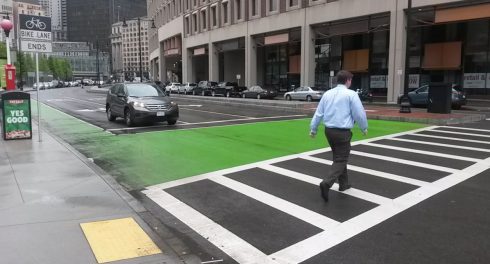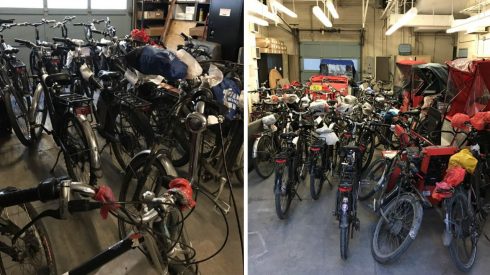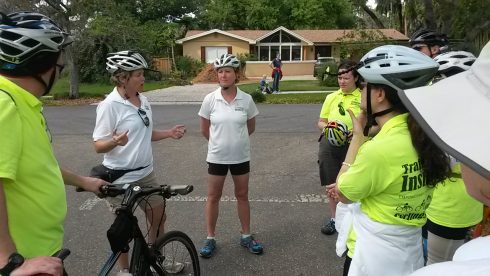Here’s a sign I just noticed for the first time, on the Minuteman bikeway, outside Boston.

Sign on Minuteman Commuter Bikeway
Until LED lights went on steroids, who would have ever thought that this would be a problem? But then, unregulated industry is ever willing to find an answer to a perceived need.
Do you think that major bicycle manufacturers are straight about safety, any more than, say, auto manufacturers were until their feet were held to the fire by Ralph Nader’s book Unsafe at any Speed and the Federal regulations it led to? (Not that auto manufacturers are straight about safety even now, witness the commercials of cars being driven at insane speeds, but that’s another story).
Latest example: Trek’s campaign for daytime running lights — not a bad idea, but I have some real problems with Trek’s advice.
A light that is visible from a long distance in daylight is blindingly bright at night. Light-emitting diodes have become so efficient that this is entirely possible with a small, battery-powered headlight. Trek markets and sells lights designed for daytime running and improperly designed for nighttime use. Trek claims that these lights are visible at distances up to a mile in daylight. These lights shine into people’s eyes and blind them at night (as with many other brands as well).
This trend is abetted by the “more is better” syndrome. Brighter must always be better, right? There are even lights marketed under the name “blinder” and “supernova”. I kid you not. Look them up on the Web — you’ll find them.
The round beam pattern of Trek’s headlights is inappropriate for nighttime use. A headlight used at night should have a flat-topped beam pattern. Automobile headlights have one. German standards for bicycle headlights require a flat-topped pattern (not surprisingly, as a lot of bicycling in Germany is on paths, and German regulators are sticklers about detail). You may read about very fine headlamps from Germany on Peter White’s web site. In the Boston, Massachusetts area, Harris Cyclery sells them, as do other discerning bike shops. (Disclaimer: a write for a Web site which has a business relationship with Harris Cyclery). Lights with a flat-topped beam pattern are available from some Asian manufacturers, too.
Trek’s advice doesn’t avoid mentioning blinding people, and also doesn’t mention the pedal reflectors or ankle bands which are required by law in Massachusetts, or the rear reflector which still alerts overtaking drivers if a taillight quits or becomes dislodged. Trek taillights do not include an integral rear reflector. Laws vary from place to place, but they generally require a steady taillight or rear reflector at night. A blinking taillight alone is hard to track with the eyes.
To use a headlight properly designed for nighttime use as a daytime running light, just tilt it upward a little so it shines into people’s eyes!
Above all though, safety needs to be active, not only passive. “Being visible is key to your safety on the road,” says Trek. Well, yeah, but lights protect you only when there is a clear line of sight between you and the person who needs to see you. Ride to be visible, and that means, among other things, pass on the left, not on the right, and on a narrow, winding country road, merge away from the right edge as you enter a blind right-hand curve.
A more detailed discussion of bicycle headlights is at http://sheldonbrown.com/LED-headlights.html
A more thorough understanding of how to be safe can be gained by taking a CyclingSavvy course, or a League of American bicyclists Smart Cycling course, Can Bike course (Canada), ROSPA Cycling Proficiency course (U.K.) reading the booklet Bicycling Street Smarts, John Franklin’s book Cyclecraft, John Forester’s Effective Cycling… Disclaimer: I am a CyclingSavvy and League of American Bicyclists instructor, and I wrote Bicycling Street Smarts.
But why do I do these things? Because I want you to be safe, to give a quick answer.
Save
Save
Save
Save





